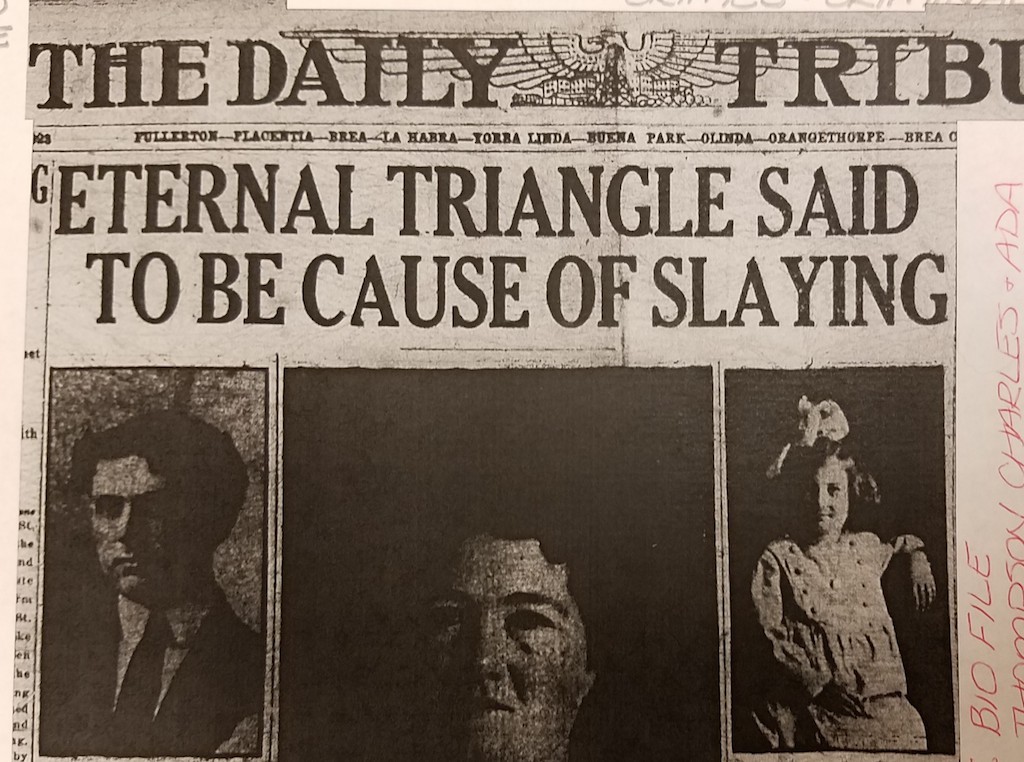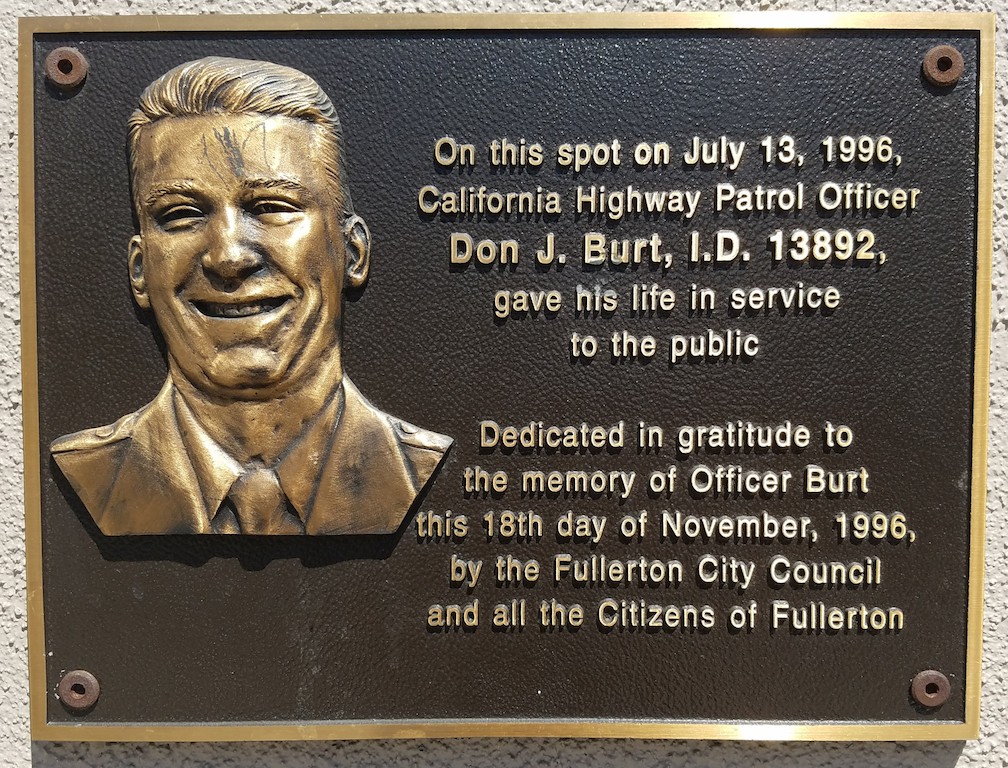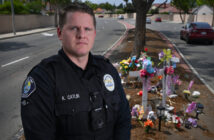From a murder case that led to the first-ever execution ordered by an Orange County court to the killing of a Major League ballplayer and two friends at the hands of reckless a drunk driver, the Fullerton Police Department has investigated some headline-grabbing murder cases over its 112-year history.
The department that serves one of the county’s largest cities also has contended with its share of perplexing, decades-old homicide cases and has a special unit tasked with trying to solve them.
Behind the Badge OC pored over volumes of old newspaper articles to piece together a list of some of the FPD’s highest-profile cases over the years.
BTB would be remiss if we didn’t knowledge the victims in these cases and the pain endured by their families.
Special thanks also goes out to the staff of the Launer History Room at the Fullerton Library for their meticulous efforts in preserving the city’s history.
Drifter murders Fullerton rancher
On July 14, 1920, Mose Gibson, a drifter, entered the home of wealthy Fullerton rancher Roy Trapp and his wife.
Gibson was intent on robbing the couple but wound up killing Trapp with a pick axe. Trapp’s wife was assaulted but survived the attack.
On the night of the murder, Gibson made his getaway in the baggage car of a passenger train that left the Fullerton Depot.
Fullerton police identified Gibson as the murder suspect after a local pharmacist reported that he had purchased a flashlight from his store that was found at the murder scene.
Gibson was arrested in Arizona three days later after a railroad ticket agent recognized him from a description put out by police.
While in custody, Gibson admitted to killing Trapp along with six other murders and more than 1,000 robberies, a crime spree that spanned from Florida to California.
Gibson was hanged at San Quentin Prison on Sept. 24, 1920 – the first execution ordered by an Orange County court.
A 1920 newspaper article reported that that Gibson’s execution ended “one of the most horrible criminal careers in the history of America.”

A newspaper headline declares that an “eternal triangle” led to the murder of Charles Thompson by his wife, Ada Thompson. Photo courtesy of Fullerton Library History Room.
Lovers’ triangle leads to slaying
The July 6, 1923 murder of a Fullerton contractor by his wife appears to be the FPD’s first murder case stemming from a sordid lovers’ triangle.
Ada Thompson shot and killed her husband Charles Thompson in the kitchen of their East Chapman Avenue home after discovering a love letter from a woman named Helen Galvin, described by a newspaper as a “pretty Los Angeles woman.”
In a July 10, 1923 article, Galvin admitted writing the letter and was quoted to have said she would “give anything” to not have written it.
Nine days after shooting her husband, Thompson’s wife hanged herself in a county hospital.

A front-page headline recorded the Cal State Fullerton shooting rampage that was at the time the worst mass shooting in Orange County history. Photo courtesy of the Fullerton Library.
CSUF killings
On July 12, 1976, Cal State Fullerton custodian Edward Charles Allaway armed himself with a .22-caliber semiautomatic rifle he purchased at a nearby Kmart and roamed the lobby and basement of the university library, shooting nine people and killing seven in a five-minute rampage, taking the time to re-load along the way.
Allaway killed Stephen L. Becker, 32, Seth Fessenden, 72, Paul F. Herzberg, 30, Bruce A. Jacobson, 32, Donald E. Karges, 41, Deborah D. Paulsen, 25, and Frank G. Teplansky, 51.
Wounded victims were Maynard Hoffman, 64, and Donald W. Keran, 55.
The atrocity remained the worst mass killing in Orange County history until the Seal Beach salon shooting in 2011, in which nine people were killed.
At the time, the university had what was essentially a part-time police force so FPD became the investigating agency.
After the shootings, Allaway drove to an Anaheim hotel where his estranged wife worked, called police and surrendered.
A former Marine and Sunday school teacher with a history of mental illness, Allaway said a group of homosexual men in a bathroom he cleaned were planning to kill him, and that his wife had been asked to appear in pornographic movies being shown in the library basement.
A judge found Allaway not guilty by reason of insanity.
He has been confined in state mental hospitals since 1977 and has petitioned for release at least five times since 1991.
Parking lot rapist
On Jan. 6, 1977, a female Fullerton College student was abducted as she was walking to her car in the parking lot adjacent to the tennis courts near Chapman Avenue.
The victim was taken to a remote area in South Orange County, where she was beaten and raped. She managed to crawl to a nearby road and get help from a couple who were driving by.
The woman provided Fullerton police with an excellent description of her attacker, which was published in newspapers and broadcast on TV.
Following a tip from a citizen, police arrested Kenneth Richard Hulbert on Jan. 30, 1977.
Investigators also connected Hulbert to the rape and murder of a 19-year-old Whittier woman, whose body was discovered in her car at an apartment complex in Fullerton.
After two sanity hearings, Hulbert was convicted of murder in 1979 and sentenced to three life sentences.
Fullerton PD solves 30-year-old cold-case murder
For 30 years, Kathy Tessanne wondered what happened to her brother, Frank “Bart” Marshall, who rode off on his motorcycle from their home in Fullerton on Jan. 2, 1982.
Marshall never was seen alive again.
FPD listed Marshall as a missing person and no clues as to his whereabouts, or whether he was alive or dead, ever turned up.
In 2011, FPD’s newly formed cold case squad decided to take another look at the case.
Marshall had been friends with David Richard Campbell, who had been serving two life sentences in state prison for the 1981 murders of William Raber and John Fischer.
The investigators confronted Campbell, who eventually confessed to killing Marshall and told them where he had disposed of his remains.
After Campbell’s confession, detectives obtained a DNA sample from Marshall’s biological brother and compared it with a DNA sample from a skull that had been discovered near Big Bear in 1985.
The skull was positively identified as Marshall’s.
In September 2015, Campbell was sentenced to nine years to life in prison for the murder, the maximum allowed for such a crime in 1982.
Husband and wife stabbed multiple times; killer blames actions on flashbacks from a horror movie
On Dec. 7, 1982, Francis Harbitz, 67, and his wife Aileen Harbitz, 68 were stabbed and bludgeoned to death during a robbery in their Fullerton home by a man they had helped out in the past.
The killer, Richard Delmer Boyer, admitted to being in the Harbitzs’ home on the day of the killings, but alleged he did not intend to kill them.
The couple knew Boyer through their son and had hired him to do chores around the house and even loaned him money a few times.
They had offered him something to eat before they were killed.
Boyer said he had taken PCP and blamed his actions on flashbacks he was experiencing from watching “Halloween II.”
He was tried three times. The first trial resulted in a hung jury. He was convicted in the second but the conviction was overturned on appeal.
In the third trial, Boyer was convicted and sentenced to death.
The death sentence was appealed and upheld by a federal appeals court in 2015.
Murder of detective’s wife remains unsolved after 30 years
Marie Malmgreen, the wife of a Los Angeles police officer, dropped her two children off at school on the morning of April 22, 1986.
A week later, Malmgreen’s blue Cadillac was found behind a Fullerton apartment complex, with her body in the back seat.
The case remains unsolved to this day.
The coroner revealed that she’d been sexually assaulted. However, an autopsy failed to establish the exact cause of death.
Police did not believe the murder was in any way related to her husband’s job as a police officer and focused their investigation on two homeless men who’d spent time in Craig Park.
One claimed on a police videotape to have knowledge of what happened, but the information could not be confirmed.
The man was charged twice with the killing, but the charges were thrown out of court.
The other man also was released.
Fullerton detectives said at the time that the case was one of the most perplexing they have handled.
Man murders mother, father and brother
In November 1994, Edward Charles III, a 22-year-old gas station mechanic, killed his 19-year-old brother Danny, his father Charles, 55, and mother Delores, 47 in their Fullerton home.
Charles stuffed the bodies in the trunk of his brother’s car, drove the car to La Mirada, and then set the vehicle on fire.
Newspapers reported that weeks after being arrested, Charles called his 73-year-old grandfather from jail and asked him to take the blame.
The motive for the murders was sketchy, but prosecutors believe Charles was jealous of his brother, an accomplished singer.
Charles was convicted and sentenced to death.

This plaque is affixed to the outside wall of a Chevron Station on Placentia Avenue, at the spot where CHP Officer Don Burt was murdered on July 13, 1996. Photo by Lou Ponsi for Behind the Badge
CHP officer killed
Shortly after 8:30 p.m. on July 13, 1996, CHP Officer Don Joseph Burt was shot and killed near the intersection of Nutwood Street and Placentia Avenue during a traffic stop.
Burt was searching the trunk of a BMW driven by Hung Thanh Mai when he discovered counterfeit travelers checks and forged payroll checks.
Mai, a gang member with a history of violence, drew a 9 mm handgun and shot Burt six times.
As the officer lay on the ground, Mai shot him execution style in the head, stole his patrol car and fled the scene.
He eventually was arrested in Houston.
The Orange County Register reported that Mai told an Orange County jury in 2000 that he should receive the death penalty.
The jury obliged.
Angels pitcher, two friends murdered by drunk driver
Shortly before 1 a.m. on April 9, 2009, Angels pitcher Nick Adenhart, 22, and friends Courtney Stewart, 20, Henry Pearson, 25, and Jon Wilhite, 24, were on their way to a Fullerton nightclub to celebrate Adenhart’s brilliant pitching performance against the Oakland A’s just hours earlier.
They never made it.
At Orangehtorpe Avenue and Lemon Street, the Mitsubishi driven by Stewart was slammed into by a Toyota Sienna minivan driven by an intoxicated Andrew Thomas Gallo.
Stewart, a former Cal State Fullerton cheerleader, Pearson, a graduate of Arizona State University, and Adenhart were killed.
Wilhite, a former Cal State Fullerton baseball player, sustained internal decapitation but survived.
Gallo sustained only minor injuries and fled the scene.
He was walking along the 91 Freeway when he was arrested an hour later.
Gallo’s blood alcohol level was three times the legal limit.
The lead investigator in the case was the recently retired FPD Cpl. Matt Malone.
In December 2010, Gallo was convicted of three counts of second-degree murder and after emotionally charged victim impact statements, was sentenced to 51 years to life.
Bank robbers nabbed
On Sept. 17, 1937, George Horine and William Morrison, both 19, overturned their car on the corner of Spadra Road (now Harbor Boulevard) and Whiting Avenue.
Fullerton Police Officer Ernie Garner arrested the pair after finding a .32 caliber Remington automatic pistol under the back seat.
The two men had robbed $760 from the Saratoga Bank of America outside San Jose four days earlier.
The men were each sentenced to five years in San Quentin.
 Behind the Badge
Behind the Badge



